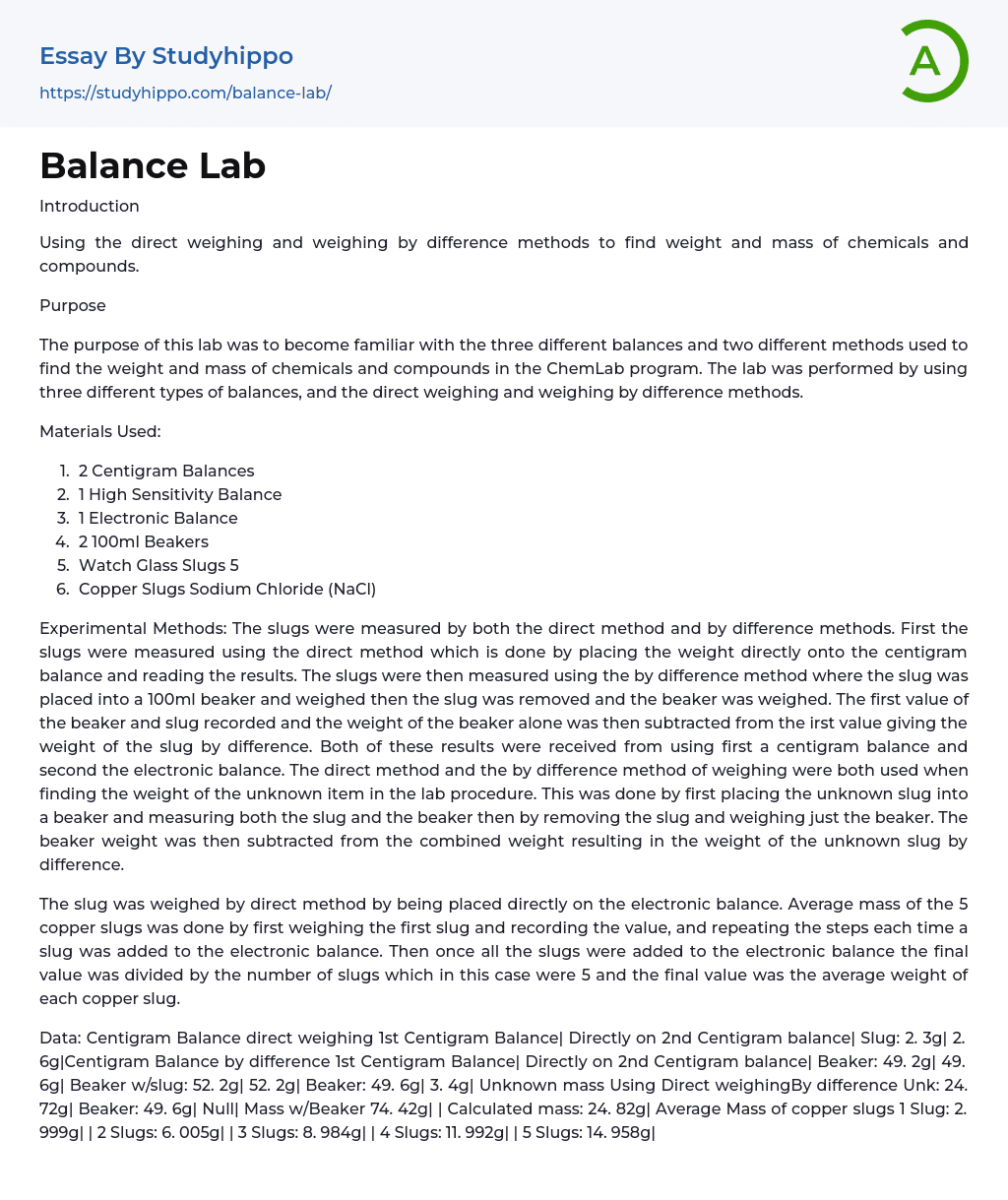Introduction
Using the direct weighing and weighing by difference methods to find weight and mass of chemicals and compounds.
Purpose
The purpose of this lab was to become familiar with the three different balances and two different methods used to find the weight and mass of chemicals and compounds in the ChemLab program. The lab was performed by using three different types of balances, and the direct weighing and weighing by difference methods.
Materials Used:
- 2 Centigram Balances
- 1 High Sensitivity Balance
- 1 Electronic Balance
- 2 100ml Beakers
- Watch Glass Slugs 5
- Copper Slugs Sodium Chloride (NaCl)
Experimental Methods: The slugs were measured by both the direct method and by differen
...ce methods. First the slugs were measured using the direct method which is done by placing the weight directly onto the centigram balance and reading the results. The slugs were then measured using the by difference method where the slug was placed into a 100ml beaker and weighed then the slug was removed and the beaker was weighed. The first value of the beaker and slug recorded and the weight of the beaker alone was then subtracted from the irst value giving the weight of the slug by difference. Both of these results were received from using first a centigram balance and second the electronic balance. The direct method and the by difference method of weighing were both used when finding the weight of the unknown item in the lab procedure. This was done by first placing the unknown slug into a beaker and measuring both the slug and the beaker then by removing the slug and weighing just the beaker. The beaker weight
was then subtracted from the combined weight resulting in the weight of the unknown slug by difference.
The slug was weighed by direct method by being placed directly on the electronic balance. Average mass of the 5 copper slugs was done by first weighing the first slug and recording the value, and repeating the steps each time a slug was added to the electronic balance. Then once all the slugs were added to the electronic balance the final value was divided by the number of slugs which in this case were 5 and the final value was the average weight of each copper slug.
Data: Centigram Balance direct weighing 1st Centigram Balance| Directly on 2nd Centigram balance| Slug: 2. 3g| 2. 6g|Centigram Balance by difference 1st Centigram Balance| Directly on 2nd Centigram balance| Beaker: 49. 2g| 49. 6g| Beaker w/slug: 52. 2g| 52. 2g| Beaker: 49. 6g| 3. 4g| Unknown mass Using Direct weighingBy difference Unk: 24. 72g| Beaker: 49. 6g| Null| Mass w/Beaker 74. 42g| | Calculated mass: 24. 82g| Average Mass of copper slugs 1 Slug: 2. 999g| | 2 Slugs: 6. 005g| | 3 Slugs: 8. 984g| | 4 Slugs: 11. 992g| | 5 Slugs: 14. 958g| | Average Mass of all slugs: 2. 9916g| | Solid Chemicals Centigram Balance| Electronic Balance| Watch glass w/sample: 10. 3g| 11. 100g| Watch glass: 9. 3g| 10. 000g|Sample by difference: 1. 0g| 1. 100g|
Results:
The data shown in the chart above is done by simple subtraction. The data was gathered by following the procedure and annotating the values as they read on both the electronic and centigram balances. The data is labeled as it
was retrieved following the procedure in the ChemLab program. All values are as they appeared on each perspective scale. Discussion & Analysis: All masses by difference were calculated by taking the mass of the slug and its container subtracted from the mass of the container with out the slug. This can bee seen in the example below.
Mass of beaker = 49.2g
Mass of Beaker & Slug= 52.2g.
Calculated mass of Slug= 3.0g 52. 2g – 49. 2g = 3.0g.
This same formula was applied to the rest of the measurements, although a different scale was used for some experiments although the values changed the formula stayed the same.
Conclusion
The purpose of this lab was to become familiar with what a Centigram Balance, Electronic Balance and High Sensitivity Balance was. Along with becoming familiar with the three different types of balances, the methods in which the mass of each item was to have it mass measured was also learned and understood.
- Accounting essays
- Marketing essays
- Automation essays
- Business Cycle essays
- Business Model essays
- Business Operations essays
- Business Software essays
- Corporate Social Responsibility essays
- Infrastructure essays
- Logistics essays
- Manufacturing essays
- Multinational Corporation essays
- Richard Branson essays
- Small Business essays
- Cooperative essays
- Family Business essays
- Human Resource Management essays
- Sales essays
- Market essays
- Online Shopping essays
- Selling essays
- Strategy essays
- Management essays
- Franchising essays
- Quality Assurance essays
- Business Intelligence essays
- Corporation essays
- Stock essays
- Shopping Mall essays
- Harvard Business School essays
- Harvard university essays
- Trade Union essays
- Cooperation essays
- News Media essays
- Waste essays
- Andrew Carnegie essays
- Inventory essays
- Customer Relationship Management essays
- Structure essays
- Starting a Business essays
- Accounts Receivable essays
- Auditor's Report essays
- Balance Sheet essays
- Costs essays
- Financial Audit essays
- International Financial Reporting Standards essays
- Tax essays
- Accountability essays
- Cash essays
- Principal essays




